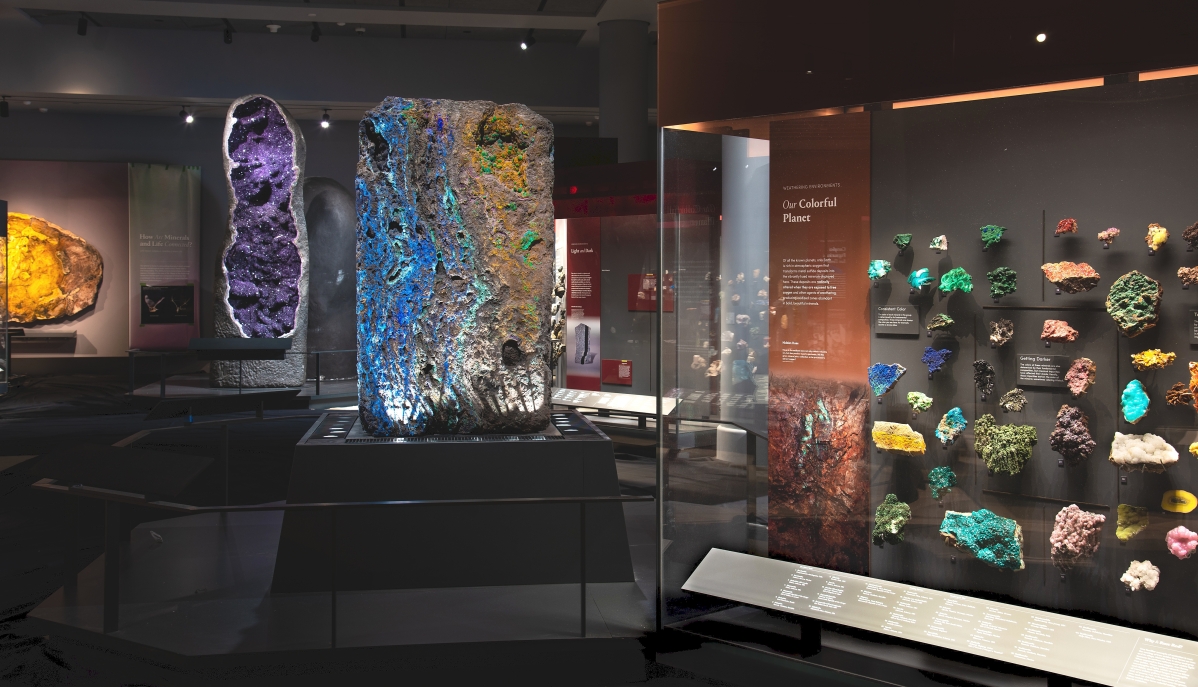
The Mineral Hall in the Allison and Roberto Mignone Halls of Gems and Minerals at the American Museum of Natural History. D. Finnin/©AMNH.
By Karla Klein Albertson
NEW YORK CITY – What could be new in the world of rocks? Not that grey boulder by the road, but one of the world’s finest collections of gems and minerals at the American Museum of Natural History on Central Park West in New York. When visitors head for the entrance, the stated purpose may have been to “take the children to see the dinosaurs,” but somehow the next stop was that room with the gigantic amethyst geode and the glowing blue Star of India.
Thanks to the generosity of two staunch supporters, the museum has the redesigned Allison and Roberto Mignone Halls of Gems and Minerals, which opened June 12. This custom-designed space – a total of 11,000 square feet – provides a perfect setting to present the polish and depth of the collection. This division has been part of the permanent holdings since the institution opened in 1869 and now includes around 200,000 specimens of minerals, gems, rocks and meteorites – and is, of course, still growing.
The couple for which the halls are named have been intensely involved with the museum’s future development; Roberto Mignone is currently a trustee and Allison Mignone is vice chair of the museum’s campaign. Gems and minerals are a special passion, so it is worth quoting her statement on what they hope to accomplish with their major gift: “The mission of the entire museum is really to educate and inspire – these newly renovated halls will awaken a sense of wonder and awe for the natural world and create excitement about scientific discovery for all visitors and generations to come.”
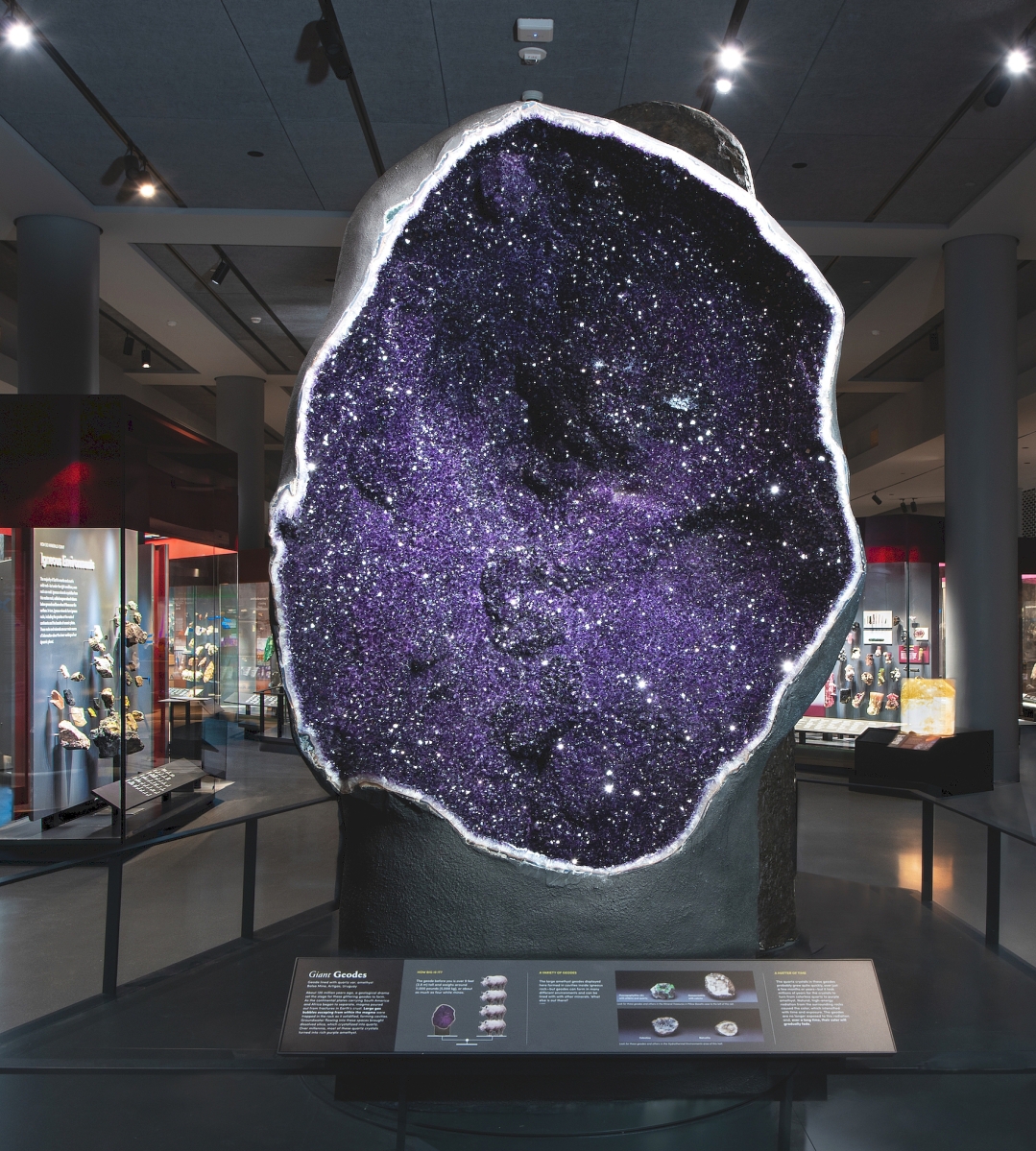
The entrance to the new galleries features a pair of towering amethyst geodes that are among the world’s largest on display. The amethyst geode pictured here stands 9 feet tall, weighs around 12,000 pounds (5,440 kg), or about as much as four black rhinos, and was collected from the Bolsa Mine in Uruguay. D. Finnin/©AMNH.
George E. Harlow is curator of the new halls and has seen many changes in his 40 years at the museum. In a conversation with Antiques and The Arts Weekly, he explained that, when he arrived, the previous hall had just opened, thus he inherited those displays: “We made various improvements on it, but – as time went by – that became harder to do. So I’ve been working for at least 20 years to do something major. Then in 2014, I was told that the stars had aligned, and we could start planning on the new hall. I’ve been working on that since then, which basically meant getting together with design teams from Ralph Appelbaum Associates and working on the various concepts and organizations to create a new hall.”
“The previous hall had been constructed in layers and had a kind of underground feel to it. It was hard to recognize the size of the space you were in. The layers turned out to be problematic, even though we had ramps. In the new conception, the idea was to open it back up to the internal structure of the building. The halls in the museum have 25-foot-high ceilings, columns supporting some of the load in the building, and it’s 11,000 square feet total. The main room appears much bigger now than it did before because you really couldn’t see the size of the space.”
The curator continues, “We constructed it so it’s very open. The cases are tall and vertical. The specimens are laid out vertically on the back of the insides of the cases. So, we have a lot to see, lots of specimens, but there’s a lot of room for people, and it has a very open organization. The cases are grouped, so you can walk around them. They’re usually grouped in sets of three. You’d have to see the organization to appreciate it, but it’s a really grand view when you walk in now with specimens visible everywhere. To be honest, it’s stunningly beautiful! And I hope it’s inviting as well as that.”
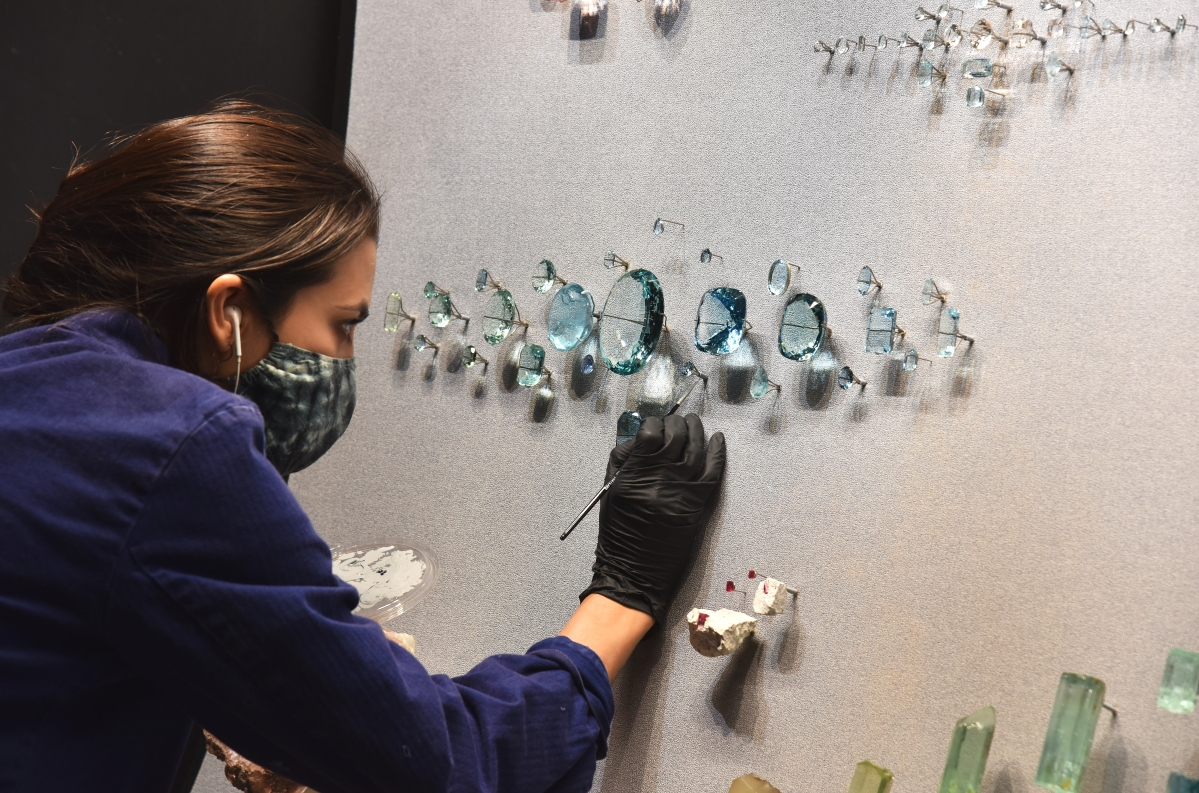
Exhibition staff members install specimens in the all-new Allison and Roberto Mignone Halls of Gems and Minerals at the American Museum of Natural History. D. Finnin/©AMNH.
“We have a lot of signature pieces – big and beautiful – but also curious pieces. My hope is that people will walk in and be drawn by something and go take a look – and that will start them on their wander through the hall. If they choose to do it systematically, you have to visit five areas and walk down a wall. There are four corners with four different messages about the role minerals play. It was a giant team effort, and it was mostly done within the museum. Everybody in the museum was pulling in the same direction, which was very important to us.”
When asked to choose a favorite display, Harlow said: “We have a smaller hall adjacent to the gem hall called ‘Minerals and Light.’ It’s somewhat of an accessory to the Gem Hall because it’s designed to explain some of the optical characteristics that are employed to make gems so attractive. By faceting them and polishing them, you can bring out some of the optical features that make them dazzling.”
In this room is one of the stars of the Halls – a slab of fluorescent rock from the Sterling Hill Mine in Ogdensburg, N.J., which operated between 1850 and 1986. The curator called it “the Capital of Fluorescent Minerals”: “Everybody had seen these, but I wanted a display where you could see both the fluorescence and the geology at the same time. You could actually see the structure of how the rocks were laid down. When that is turned on, it is truly awesome. That is a giant lollipop at the end of the Hall.”
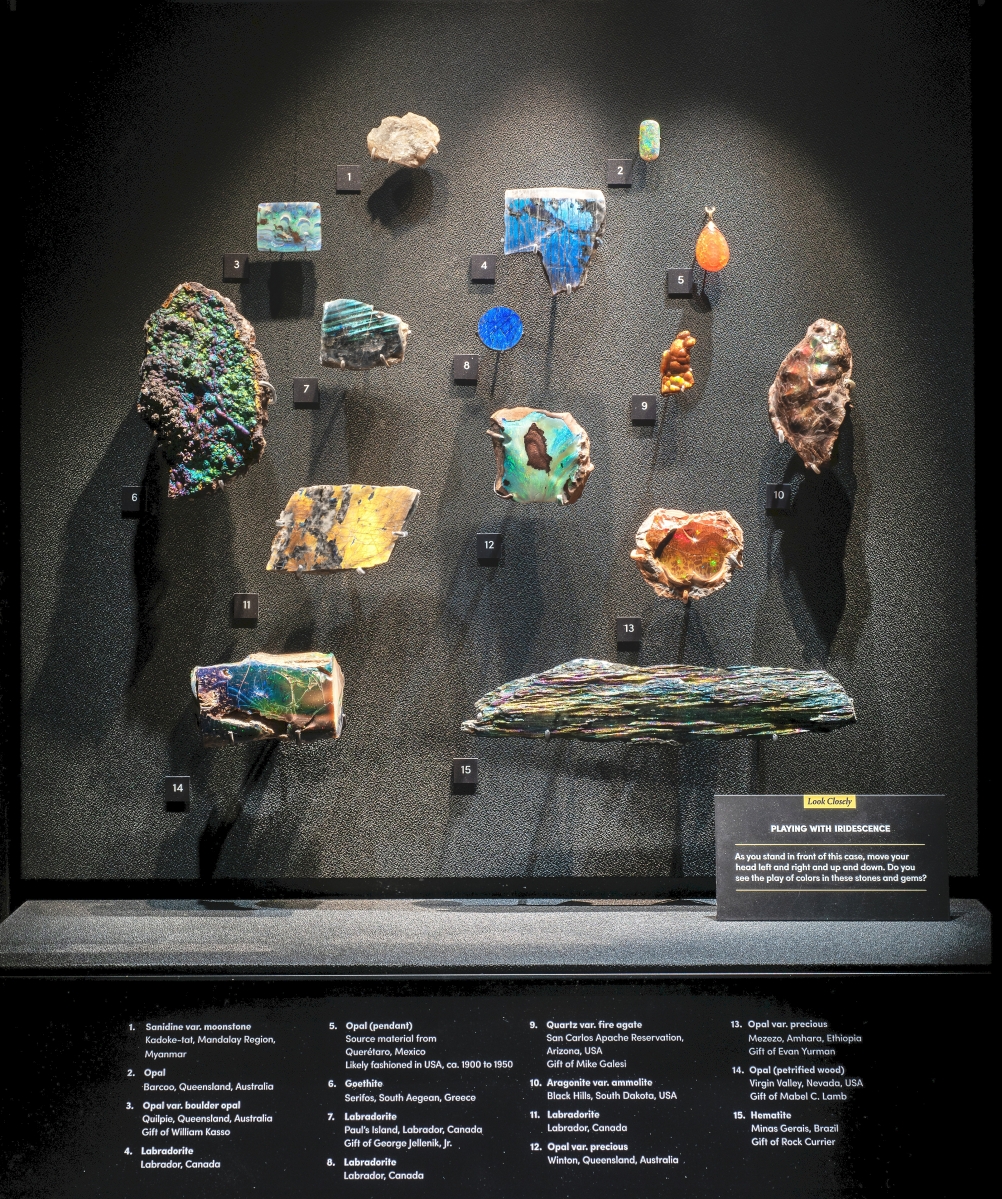
This case highlighting iridescent specimens is part of the Minerals & Light room, which explores the optical properties of minerals and their interaction with light. D. Finnin/©AMNH.
While the installation of the permanent collection is the primary focus, the museum has also added the Melissa and Keith Meister Gallery, its first ever space for rotating exhibitions within a permanent hall. And the first show is exactly what a proper gem-admirer could hope for: “Beautiful Creatures” curated by jewelry historian Marion Fasel, author of the companion book Beautiful Creatures: Jewelry Inspired by the Animal Kingdom (2020). These are not kittens and puppies but more exotic creatures such as a Cartier Paris flamingo brooch that once belonged to the Duchess of Windsor.
Fasel explained her choices as she collected jewelry for this loan exhibition: “Because it was conceived as a tribute to the museum’s 150th anniversary, the theme is animal jewelry because it celebrates the animals that are in the museum. They’re all creatures of the wild, they’re not domestic or barnyard animals or anything cutesy – no, no, no. These are wonderful wild creatures.”
“There are 104 jewels in the exhibition, and I sourced all of them. Some of them come from private lenders with collections, and some of them come from corporate archives. For example, Cartier certainly has one of the most extensive corporate jewelry collections, and we were lucky enough to get 11 of those pieces. There are a few, maybe five or six, contemporary jewels from the last 20 years. It’s 150 years of jewelry, so I wanted to bring the pieces as much up to the present as I could to show how the idea of animal-themed jewelry still inspires designers to this day.”
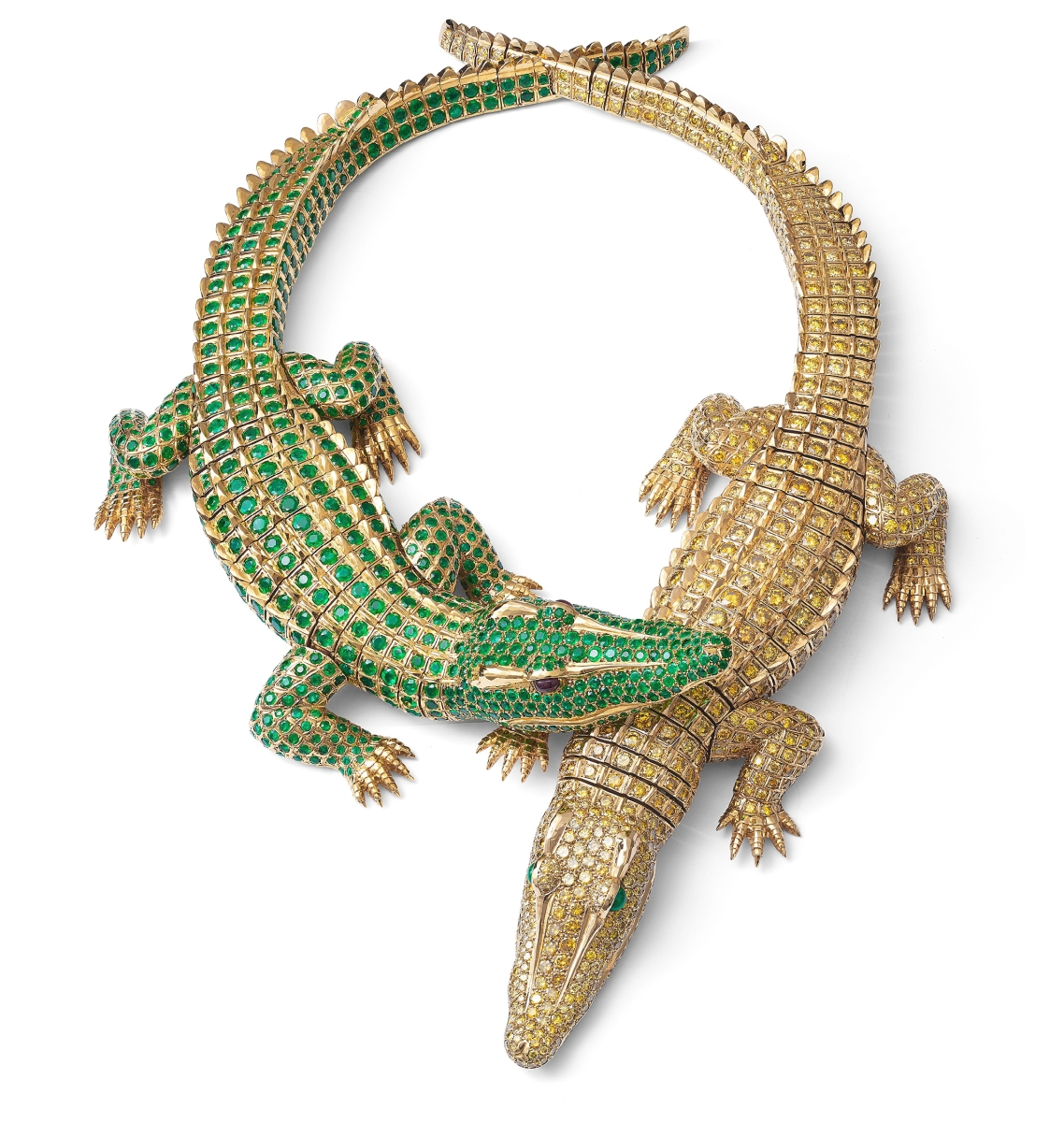
According to legend, when actress María Félix commissioned this necklace, she carried live baby crocodiles into Cartier in Paris to serve as models for the design. The realistic sculpting of the gold includes the scutes of a crocodile’s skin. There are 60.02 carats of fancy intense yellow diamonds and 66.86 carats of emeralds in the setting. From “Beautiful Creatures.” Credit: Nils Herrmann, Cartier Collection © Cartier
The curator stressed, “I think when people first hear of this idea of animal-themed jewelry, they think this might be totally light hearted – but it’s not. It’s very joyous and delightful, but there are many things to learn from these pieces of jewelry. They teach us about jewelry techniques over the last 150 years. For example, in those more contemporary pieces where jewelers are experimenting and using, quite brilliantly, titanium.”
Fasel continued, “You learn about jewelry techniques and technology, about different gem stones that came in and out of style, and also about culture and how the animals were reflecting different things that were happening in society. For example, at the end of the Nineteenth Century, when people were collecting insects and butterflies, there were many of those creatures depicted in jewelry because jewelers were responding to that public fascination.”
“As a jewelry historian, I’ve never worked with subject matter where that was ever more clear – how jewelers are responding to the public’s general interests. For example, rod and reel fishing was popular in America in the 1920s through 1950s so there are charming diamond and sapphire fish brooches that represent a great catch. I want people to discover many different layers in this book and the exhibition.”
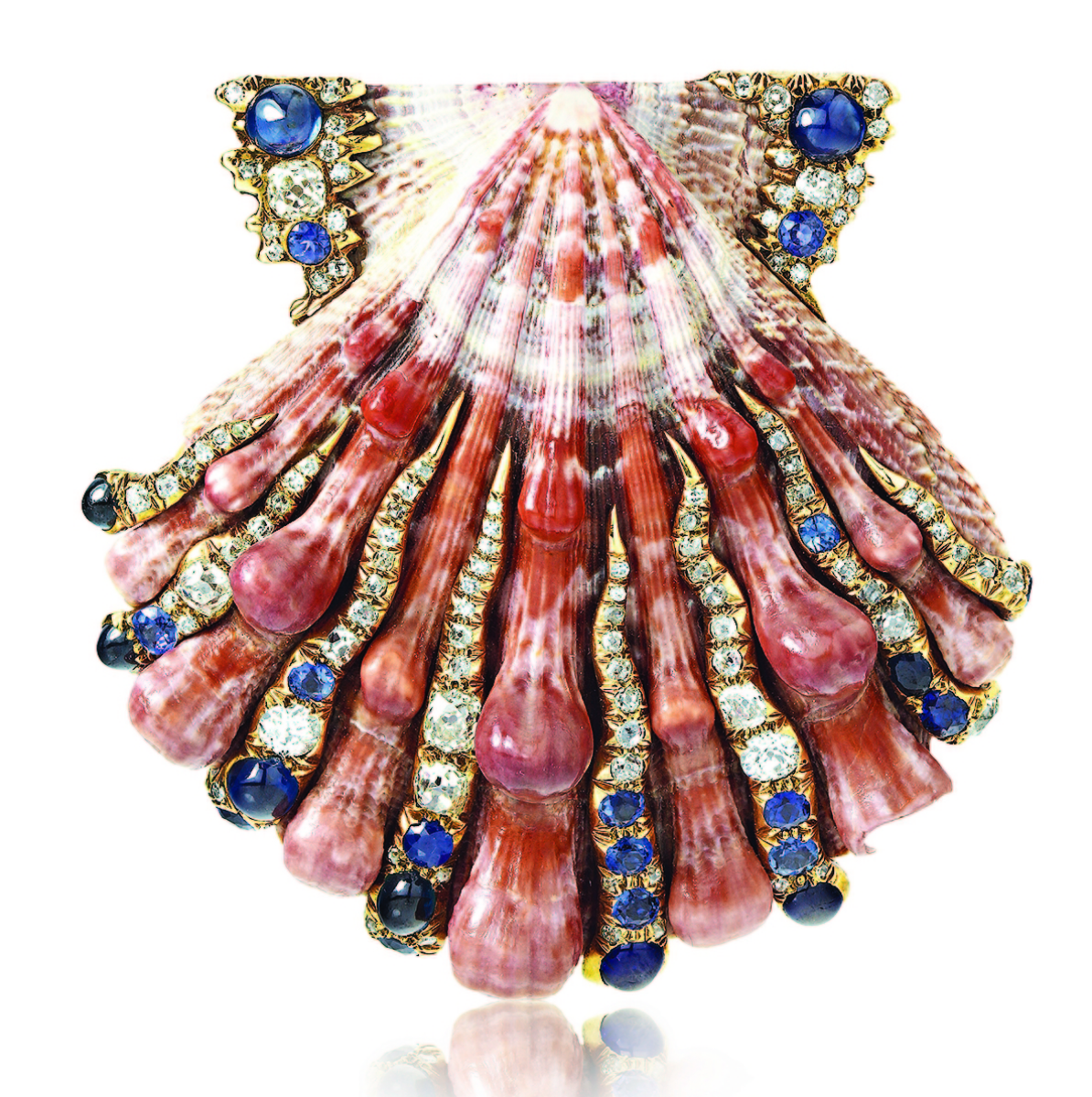
Two Verdura lion’s paw shell brooches, made from lion’s paw scallops purchased by the Italian designer Duke Fulco di Verdura in the museum’s gift shop in 1940, are on display in “Beautiful Creatures,” including this one. Courtesy of Stephen Webster.
Fasel hopes that the animals convey a sense of wonder and magic that will appeal to children as well as their parents. She admits her own favorite is the starfish designed by Salvador Dalí, its arms set with rubies and diamonds: “I love how imaginative it is – it’s really a masterpiece that people are not familiar with even though they know the name Salvador Dalí. I also like the double crocodile necklace that actress María Félix commissioned from Cartier. Clients could push an excellent jeweler even farther.”
From the Allison and Roberto Mignone Halls of Gems and Minerals to the special jewelry exhibition of “Beautiful Creatures,” the Museum of Natural History is inspiration point this summer. Leafing through biographies, so often it is just such a single glimpse – one afternoon at the museum – that proves the catalyst for a scientific career that takes knowledge a step beyond. Went with the children? Time to return. This classic American institution is a place where there are always new old things to see.
Find the Museum of Natural History and take that look at 200 Central Park West in New York City. The links at www.amnh.org provide maps and paths to all the permanent and temporary exhibitions.























